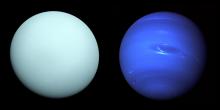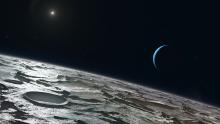Listen to today's episode of StarDate on the web the same day it airs in high-quality streaming audio without any extra ads or announcements. Choose a $8 one-month pass, or listen every day for a year for just $30.
You are here
More Neptune
No matter where you are on Earth, the length of a day is always 24 hours. That’s because our planet has a solid surface, so everything turns at the same rate. But that’s not the case on the giant outer planets. Not only do they not have solid surfaces, they don’t have surfaces at all. Instead, their outermost layers are made of gas. So as these planets turn, different regions can spin at different rates.
That’s especially true of Neptune, the Sun’s most remote major planet. Overall, the giant world spins once every 16 hours. But the zone around its equator takes 18 hours to make one turn, while the regions around the poles make a turn in only 12 hours.
That creates powerful winds at the boundaries between different regions. They can blow at hundreds of miles per hour — some of the fastest winds in the entire solar system.
The different rotation rates at the surface suggest that different zones inside Neptune turn at different rates as well. But measurements of the planet’s interior aren’t good enough to confirm that possibility.
Neptune is putting in its best showing of the year right now. It rises at sunset and is in view all night, in the constellation Aquarius. It’s brightest for the year, too. It’s so far and faint, though, that you still need a telescope to see it. It’s not far to the lower left of the Moon this evening — a small blue dot shining feebly through the moonlight.
We’ll have more about Neptune tomorrow.
Script by Damond Benningfield





